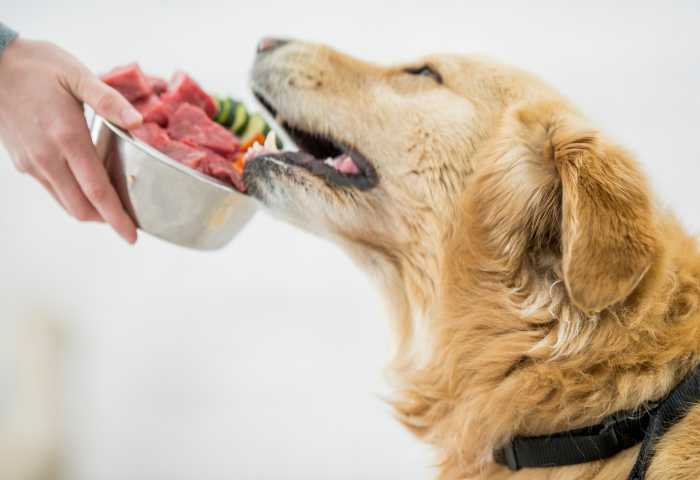A quick guide to raw feeding
For more advice and in depth help consider our Diet Consults, or stop by the store to chat with our educated staff.
How much to feed
Adult dogs: 2-3% of ideal body weight, or 100g-150g for every 10lb.
Puppies: 4-6% of ideal body weight, or about 250g for every 10lb.
15lb dog = 150g or ⅓lb/day
40lb dog = 400g or 1lb/day
60lb dog = 600g or 1.5lb/day
These are suggested guidelines; check in visually and feel your dog's ribs to see if they are over or under eating.
How much will it cost?
Exact cost will depend on whether you buy bulk, which proteins you feed, and which brand you buy.
Raw food ranges from $3.6/lb in the most economical to $12/lb for organic ingredients and novel proteins. Remember you will be rotating proteins so consider cost on an average:
15lb dog = $1.2-$2.8 / day ~ $60/month
40lb dog = $3.5-$8 / day ~ $170/month
60lb dog = $5.25-$12 / day ~ $250/month
Can I mix raw and dry?
The short answer is yes. We have many clients who combine raw and kibble with no problem. We suggest feeding them as separate meals. You can also consider a less processed food like dehydrated rather than combining two diets.
Diet Transition
When switching to any new diet, you have a few options:
Quick and Easy
Recommended for adult healthy dogs only.
Go from one diet to another "cold turkey". Day one you're feeding your initial diet, day 2 you fast your dog, day 3 you start feeding the new diet. The fasting day is optional.
Slow and Gentle
Slowly switch the ratio of raw to kibble in 1-2 weeks. Separate the types of food into two meals, dry in the morning and raw in the evening.

Transition Support for Sensitive Stomachs
If your dog has a history of GI upset, raw can still work for you! Take precautions to make the transition easier.
1 week before transition
- Soak kibble 15-30 min before feeding
- Add probiotics
- Incorporate freeze-dried or gently cooked foods
During transition
-
Add digestive enzymes, probiotics, bone broth, or goat kefir
-
Feed after the longest period of exercise
During Transition, Some Dogs May Experience:
- Soft stool
- Increased eye, ear, or skin discharge
- Dry skin/excess shedding
If this happens, slow down the transition and provide gut support.
Balancing the Diet
Most prepackaged raw food in our store has:
- 70% lean muscle meat
- 10% organ
- 10% bone
- 10% vegetables
Protein Rotation
To achieve a balanced diet, we suggest rotating proteins weekly or every few weeks. The easiest way to do this is buying a new protein each time, or buy a variety box.
A 3:1 white:red ratio is recommended

Balanced Recipes
We also carry certified balanced recipes with added supplements and vitamins from Iron Will Raw. Our staff can help you find a rotation or premade mix that works for you and your family!
If you can't rotate proteins due to allergies, consider a multivitamin supplement.
Pro Tips
Each meal time, pull out the next meal from the freezer so you always have something thawing.
Use stainless steel, glass, or silicone bowls, never plastic.
Never cook meals containing bone.
Wash your hands and any contacted surfaces after feeding.
Raw Bones
Feeding raw bones helps supplement your dog's diet, clean their teeth, and provide mental stimulation. We suggest you start feeding them 2-3 times a week once you've made the transition.
Check out our other resources to learn about how to choose the right bone for your dog!

